
surfresearch.com.au
dumont d'urville : astrolabe, 1826
dumont d'urville : astrolabe, 1826
|
|
|
|
|
|
 |
surfresearch.com.au
dumont d'urville : astrolabe, 1826 |
| Introduction The first French ship named Astrolabe was a converted flûte built in 1781 at Le Havre, originally named the Autruch. The name derives from an early navigational instrument, a precursor to the sextant. In 1785, the Boussole (previously the Portefaix) commanded by comte de Lapérouse and the Astrolabe under Fleuriot de Langle departed for a round-the-world voyage of scientific exploration. The two ships were last reported sheltering in Botany Bay in 1788, while Arthur Phillip was establishing the English penal settlement at Port Jackson, before they disappeared in the Pacific. The second Astrolabe was a horse barge, first named La Coquille, and converted to an exploration ship of the French Navy. As La Coquille and commanded by Louis Isidore Duperrey, with Jules Dumont d'Urville as second, she circumnavigated the globe in 1822–1825, visiting the Falkland Islands, Chile, Peru, New Zealand, New Guinea, Australia, and the archipelagos of the Pacific. Following the success of this expedition, the renamed Astrolabe, under the command of Dumont d'Urville, departed Toulon in April 1826 on another voyage. |
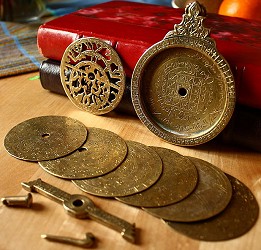 |
| Page 64 22nd November 1826 The calm persisted with light variable winds from all directions. We saw the heights of the Ram's Head again, and after midday, the sky having cleared, clearly made out the range of high mountains that follows the coast from headland towards Wilson's Promontory. As there is a distance of about twenty to twenty-five leagues between us and the coast we must conclude from that that this range is very high and certainly higher than all those we have observed on all points of this great land. Numbers of pink and violet coloured jellyfish floated continually just below the surface. The two following days calms still alternated with light uncertain breezes, the weather superb and the sea smooth. However, on the 24th we succeeded in coming in close to Cape Howe and, from 6 to 7 p.m., we coasted the little low island lying just off the Cape at a distance of four or five miles. The Cape itself offers only a sandy beach overlooked by high forest-cover peaks some distance from the shore. On the part of the coast running north can be seen big sand dunes bare of vegetation. The whole day the inland was Page 65 |
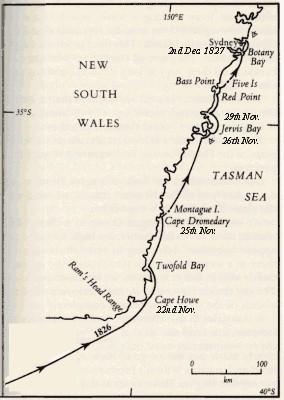 Voyage
of the Astrolabe,
Cape Howe to Sydney, 22nd Nov - 2nd Dec 1826. - Volume 1, page 63. (detail and adjusted) |
|
Louis Auguste de Sainson:
The Astrolabe at the entrance to
Jervis Bay, 1826.
- Dumont d'Urville: Voyage de la Corvette l'Astrolabe Paris (1830-4) Plate 24. {New scan required 200-300dpi high} |
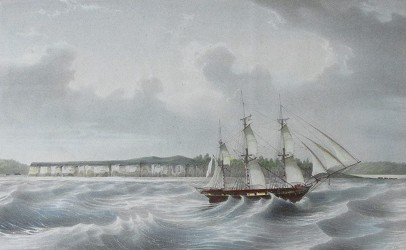 |
|
Dr. Quoy had reason to
be pleased.
Before 1802, no trigonia fossil had been found that was less than 66 million years old, until François Péron discovered a living species in waters off the coast of Tasmania. Renamed the genus Neotrigonia in 1912, five living species have been identified, all found off the coast
of Australia.
Photograph:
Wikimedia
Commons
|
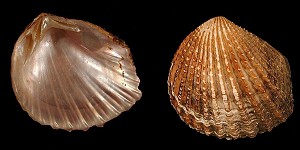 |
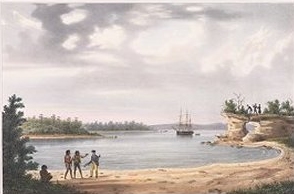 |
Louis Auguste de Sainson: The Astrolabe, moored in nine fathoms, fine sand and shells, three cables from the beach at Hole-in-the-Wall, Jervis Bay, 1826. - Dumont d'Urville: Voyage de la Corvette l'Astrolabe Paris (1830-4) Plate 25. |
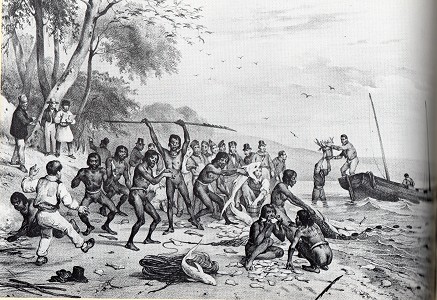 |
Louis
Auguste de Sainson:
Sharing the catch, Jervis Bay, 1826. Dumont D'Urville: Two Voyages to the South Seas Volume 1: Astrolabe 1826-1829 Translated by Helen Rosenman Melbourne University Press, 1987, facing page 91. At the National Gallery of Australia |
|
Collecting
pippies on the shore near Port Macquarie, circa 1910.
When Dumont d'Urville wrote that in the sand another
species of larger and more succulent oyster is found,
he was referring to the common sand pipi (plebidonax deltoides).Photograph: Thomas Dick, Australian Museum. Removed by request of members of the Birpai community. - noted, with thanks, by Vanessa Finney, AM. The sand pipi is simply harvested, and a staple food of the Aboriginals of the east coast. |
Dr. Quoy's very odd Philipp
shark,
now commonly known as the Port Jackson Shark. - Catalogue of the Fishes of South Australia,1921. |
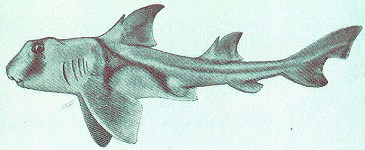 |
|
Pirogue de la Baie Jervis, Nouvelle
Holland par Paris, 1826.
[Canoe of Jervis Bay, New Holland by Francois-Edmond Paris, 1826.] - Dumont d'Urville: Voyage de la Corvette l'Astrolabe Paris (1830-4) Plate 36 (detail). |
 |
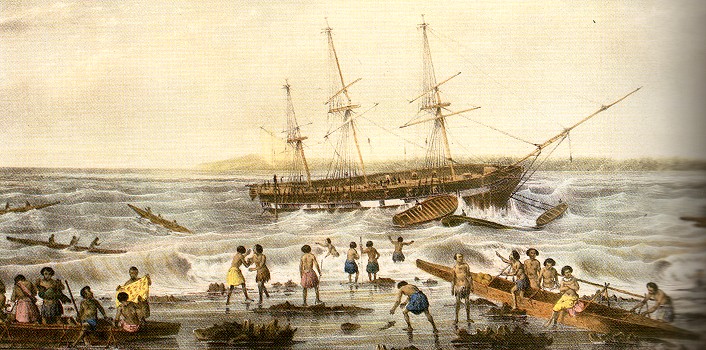 |
Louis Auguste de
Sainson: Astrolabe on the reefs of Tongatapu. (National Library of Australia) Dumont D'Urville: Two Voyages to the South Seas Volume 1: Astrolabe 1826-1829 Translated by Helen Rosenman Melbourne University Press, 1987, facing page 219. |
The Voyage of the Astrolabe, Cape Howe to Sydney, 22nd November - 2nd December 1826. - Dumont d'Urville: Two Voyages to the South Seas (1987) Volume 1, page 63. (detail and adjusted) |

|
The Lady Denman
Maritime Museum holds
original copies of the prints featured above, a 17th century astrolabe (Halloran Collection: HIN117), and a large scale-model of the Astrolabe, located in the Jervis Bay History Gallery. |
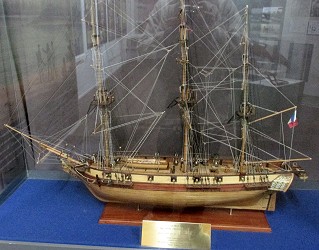 |
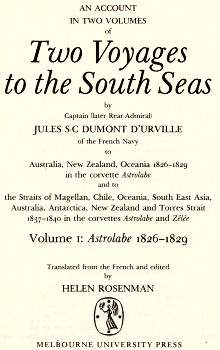 |
Dumont D'Urville: Two Voyages to the South Seas Translated by Helen Rosenman Melbourne University Press, 1987. Volume 1: Astrolabe 1826-1829 Introductions by Helen Rosenman Trove http://trove.nla.gov.au/work/12818593 |
|
|
|
|
|
|